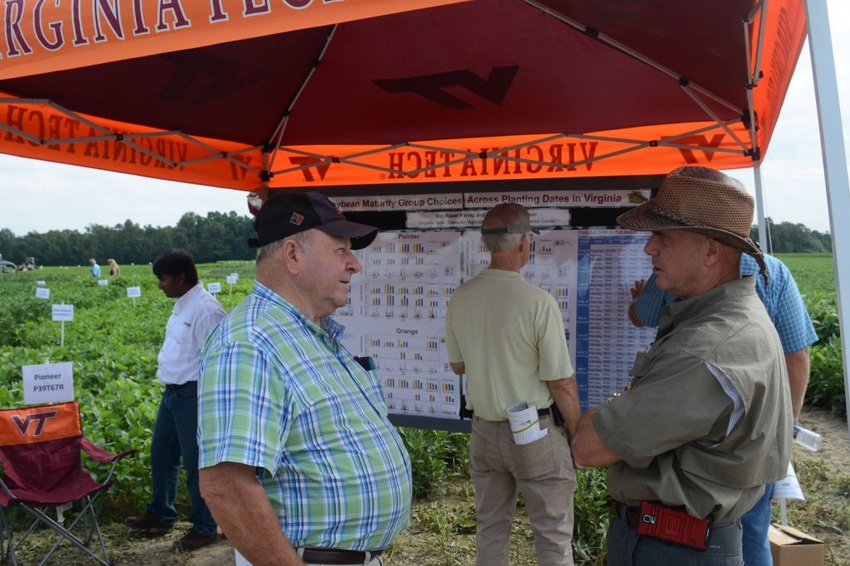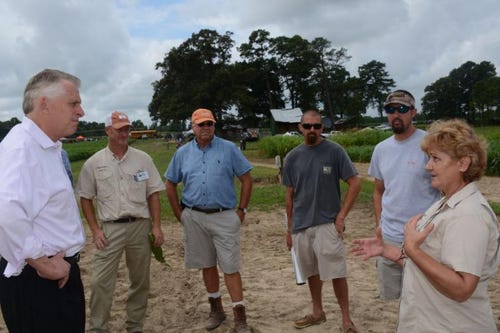
This year’s Virginia Ag Expo featured a self-paced tour which allowed the more than 1,800 participants to discuss firsthand with Virginia Tech experts the issues they face in producing crops in Virginia.
The highly popular annual tour was held Aug. 4 at Billy Bain’s Double B Farms near Dinwiddie and included a sorghum variety test plot, a peanut variety test plot, a drone demonstration and demonstrations on soybeans, forage, sweet potatoes and beef cattle. Virginia Tech research efforts in corn, small fruits, cotton and tobacco were highlighted as well as the university’s work in pork production. Participants included Virginia Gov. Terry McAuliffe who was on hand to learn more about agriculture in the commonwealth.
Double B Farms does not currently produce cotton or tobacco, but two cooperators were enlisted by the Virginia Cooperative Extension Service to produce cotton and tobacco for the tour. Local Dinwiddie farmer Mark Spiers is growing the tobacco plot for the tour while local farmer Randy Everett is growing cotton for the expo.
At Double B Farms, Virginia Tech is conducting non-irrigated and irrigated peanut trials of both runner and Virginia peanuts. Maria Balota, associate professor of crop physiology at the Tidewater Agricultural Research and Extension Center in Suffolk, explains that Birdsong Peanuts is urging Virginia farmers to produce more runners so research is looking at how runners compare to Virginias in the state.
“We are looking at the growth and development of nine Virginia and runner market-type cultivars including Bailey, Sullivan, Wynne, Sugg, Turfrunner 297, Turfrunner 511, Georgia 09B, Florun 107 and Florida 07,” Balota explained.
At the cotton stop, Virginia Tech Cotton Specialist Hunter Frame noted that the university has changed its nitrogen fertility range from a flat rate of 60 to 90 pounds per acre to a recommendation of 50 pounds of nitrogen per expected bale of yield.
“If you want a two bale per acre yield, you want at least 100 pounds of nitrogen out there,” Frame explained.
However, for an expected three bales per acre yield, applying 150 pounds of nitrogen is likely too much fertilizer and farmers need to take soil nitrogen into account before over applying fertilizer.
“Don’t over apply nitrogen,” Frame cautioned. “Cotton is a perennial plant. When you put down to much nitrogen, it takes off vegetatively, particularly with hot temperatures and good soil moisture. It’s tough to slow the plant down in the fall.”
Frame advises farmers to apply 20 to 30 percent of their nitrogen either pre-plant or at planting and 70 to 80 percent of their nitrogen in season, in either one or two applications. He encourages in-season monitoring with tissue testing.
What maturity level is best to get max soybean yields?
For soybeans, Virginia Tech Soybean Specialist David Holshouser said the biggest question he gets from Virginia farmers is which maturity level is best to achieve maximum yields.
For a full season system in southern Virginia’s Piedmont region, Holshouser encourages farmers to plant primarily group 5 soybeans. He suggests a mixture of 40 percent late 5s, 40 percent early 5s and perhaps 20 percent late 4s. “Look at some late 4s because 4s have been doing well under certain environments. However, you can still lose your shirt to 4s,” he said.
In planting soybeans, Holshouser advises southern Virginia farmers to look at Virginia Tech’s variety test data, weather conditions, soil type and planting date to determine the right combination of late 5s, early 5s and late 4s.
Double crop soybeans are different, Holshouser stressed.
“I still stand by the recommendation of growing the latest maturity possible that won’t get hit by frost. We are trying to build leaf area index with double crop beans,” he said.
In the meantime, Wade Thomason, grain crop specialist at Virginia Tech, expressed concern about the impact of high nighttime temperatures this summer on grain fill in Virginia corn.
“Anytime you have nighttime temperatures above 70 to 75 degrees, you run into nighttime respiration so the plant instead of using the sugars it makes during the day to fill kernels actually uses it to shun and deal with those high nighttime temperatures. The enzyme systems just don’t function as well under high nighttime temperatures.”
Thomason explains that comes from corn historically being from the high mountainous area of central Mexico with warm, sunny days and cool nights. “We had a lot of nights in the 70s and even 80s in late July in this field,” he noted. “Kernels were fertilized and started to fill and are now being aborted. I think this is going to cause us not to fill as many kernel as what we would have normally expected.”

Virginia Gov. Terry McAuliffe, far left, learns about Virginia Tech peanut variety research from Maria Balota, far right, associate professor of crop physiology at Virginia Tech’s Tidewater Research and Extension Center in Suffolk. Looking on is Virginia Cooperative Extension agricultural specialist Douglas Redd and Isle of Wight County farmers Larry Darden and sons Clay Darden and Andrew Darden.
About the Author(s)
You May Also Like






